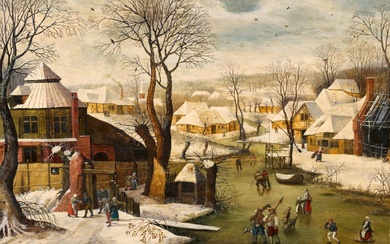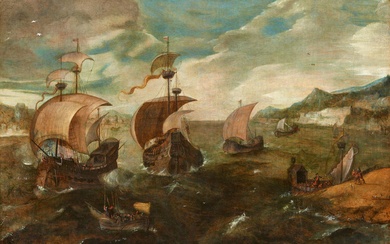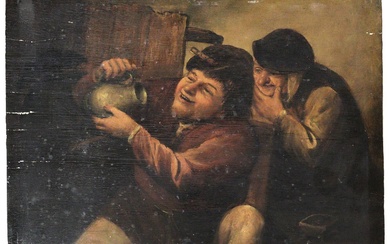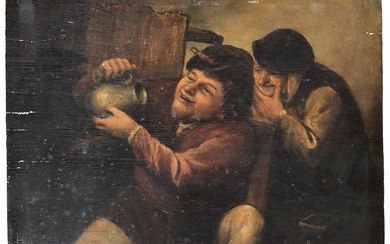Pieter Brueghel II
(Brussels 1564/65–1637/38 Antwerp)
The King Drinks,
signed lower right (on the terracotta bowl): P BRVEGHEL f.,
oil on panel, 75 x 105 cm, framed
Provenance:
probably collection of Comte Robert de Montesquiou (1855–1921), Paris (1907);
Private European collection, since circa 1907
Literature (probably):
G. H. de Loo, Peter Bruegel L‘Ancien, Brussels, 1907, p. 378, under no. 22;
G. Marlier, Pierre Bruegel le Jeune, Brussels, 1969, p. 356, under C;
M. Diaz Padron, La Obra de Pedro Brueghel el joven en Espana, in: Archivio Espanol de Arte, Madrid 1980, p. 311;
K. Ertz, Pieter Brueghel der Jüngere – Die Gemälde mit kritischem Oeuvrekatalog, vol. I, Lingen, 1988/2000, p. 535, no. F 584
The present painting comes with a written certificate issued by Klaus Ertz (March 2018).
Ertz writes: ‘The painting to be assessed, Carnival Scene in a Rustic Interior, is known to me in the original. After thorough examination of the painting I am convinced that it is by the hand of the Flemish painter Pieter Brueghel the Younger. The painting can be said to be in very good condition. The paints have been applied thickly in the impasto technique and give a fresh and brilliant impression. The overlapping glazes have survived in perfect condition […]. For some of the most important depictions of interiors entitled Carnival Celebration, The King Drinks or At the Peasant’s Cottage, the prototype was provided by Marten van Cleve instead of his contemporary Pieter Bruegel the Elder, the great example of his son, Pieter Brueghel the Younger. An etching by Balthasar van den Bos, entitled Peasant Feast and dated before 1560, based on a Marten van Cleve composition is proof that such an original by Van Cleve existed (see fig. 1 and K. Ertz, C. Nitze-Ertz, Marten van Cleve, Lingen 2014, p. 59, fig. 75; in his catalogue raisonné of Marten van Cleve’s paintings, Ertz lists altogether seven versions of this subject). There can be no doubt as to the painter’s exemplary role for this type of depiction. Pieter Brueghel the Younger painted several versions of this composition (see K. Ertz, C. Nitze-Ertz, Pieter Brueghel der Jüngere, vol. I, Lingen 2000, cat. nos. 576–585), all of which hark back to a spatial solution typical of Marten van Cleve that repeatedly occurs in interiors assigned to this painter: a box-like space opening towards the spectator and enclosed on three sides, defining the scene of a lively hustle and bustle. Views through windows and doors create a connection to the outer world, which is only fragmentarily rendered and manifests itself as space in its own right.’
Ertz continues: ‘In the print mentioned above appears a poem that makes reference to the content of the scene and explains it: It is Shrove Tuesday. The family has gathered around a table laden with food and drink, feasting and chasing winter away before the frugal Lent season arrives in this humble home. Yet today waffles are baked over an open fire and a pork ham is customarily carved out from the middle with a knife to the accompaniment of music, dance, and lots of beer. A look outside proves that it is still winter, with the landscape still covered in snow. A couple identified by their attributes as Carnival and Lent enters the scene as dancers instead of enacting a battle, such as in Pieter Bruegel the Elder’s famous painting The Fight between Carnival and Lent in Vienna. For these bulky figures, the dancing step performed by the man near the left margin may seem a bit too graceful to be taken seriously. On the whole, the picture contains a lot of satire and amusing undercurrents. A young child seems to be afraid of the new arrivals, burying its head in the paterfamilias’s lap, whereas another child is not irritated at all, licking out a pot together with a cat – all this taking place in the immediate vicinity of a chamber pot that has insinuatingly been mounted by a cockerel, with two hens rushing towards it. The man by the fireside, somewhat cut off by the right margin, has taken off one of his wooden shoes to warm his frozen foot; a donkey-eared figure disguised as a jester devours pancakes while gesticulating heavily. Everything is in motion, every single figure engaged in a performance or recital – a lively scene that one seems to be able to perceive with one’s ears.
It cannot have been difficult for Pieter Brueghel the Younger to modify Van Cleve’s bulky and somewhat clumsy figures to his own liking. His hand is betrayed in the more delicately modelled faces and in the wintry scenery so typical of his art, which, in this form, is unknown in Van Cleve’s oeuvre. Pieter Brueghel the Younger dealt with the theme of Carnival Celebration in a Rustic Interior in several variants. What is generally perceived as formulaic and boring repetitions frequently painted by workshop assistants and exhibiting a lack of artistic interest is certainly not to be felt here. In my opinion, the painting to be assessed is an autonomous re-interpretation of a model invented by Marten van Cleve unknown today. The present painting also includes elements of style typical of Pieter Brueghel the Younger. In its supreme painterly perfection and brushwork meticulously describing every tiny detail, this version is one of the most accomplished interpretations of the theme.’
To corroborate the attribution of the present painting to Pieter Brueghel the Younger, Ertz mentions the following original works by Brueghel of the same subject matter: 1) private collection, Madrid, signed and dated: P. BREVGHEL 1620 (see Ertz, op. cit., cat. no. 576);
2) Museo Stibbert, Florence, signed: P. BREVGHEL (see Ertz, op. cit., cat. no. 577); 3) sale, Sotheby’s, London, 4 April 1984, lot 44 (see Ertz, op. cit., cat. no. 578). Another version of the present painting has appeared on the art market at Koller, Zurich, 18 September 2015, lot 3010.
Ertz writes further about the date of execution: ‘All of the examples mentioned date from the period after 1616, which is suggested by the two paintings signed BREVGHEL. In all of the paintings done after 1616, the usual sequence of letters is BREVGHEL (i.e. ‘E’ before ‘V’), whereas before 1616 they were signed BRVEGHEL (i.e. ‘V’ before ‘E’). This means that the painting to be assessed is the only signed painting known to date that was painted before 1616. So far there has been no deviation from this rule!’ In his monograph on Pieter Brueghel II (op. cit., vol. I, pp. 532/33), Ertz writes about his reading of the painting, whether entitled Carnival Celebration in a Rustic Interior or The King Drinks: ‘The composition chosen by Pieter II, which, by the way, lacks the erotic allusions that otherwise form an integral part of rustic dance scenes, actually combines two different customs: in its culmination of revellers proclaiming “The king drinks!”, the scene around the table refers to the feast of the Epiphany or Three Kings’ Day, whereas the masked figures rushing into the room stand for a carnival celebration. This combination of rituals normally separated by time rarely occurs in the visual arts, but is not entirely unusual. “Many customs formerly separated by several weeks have blended together, but in some other places have been kept apart to be celebrated separately between December and May. One must bear in mind that formerly carnival or Shrovetide comprised several weeks. Sometimes carnival was thought to begin on 26 December, 1 January, or Epiphany” (E. Fehrle, Deutsche Feste und Volksbräuche, Leipzig 1916, p. 31, quoted from K. Ertz, op. cit., pp. 532/53).’
Technical analysis:
As usual for Pieter Brueghel II and its workshop, the white ground preparing the panel shows the texture of the large horizontal brushstrokes under the colour film. The painting was applied with the typical style of this master, without melting the brushstrokes too much, with a scarce evidence of glazing.
The outline underdrawing visualized by IR reflectography is very accurate, full of details, probably made with a black chalk. Its characteristics suggest the use of a cartoon, or more likely a carbon-copy transferring process from a drawing, as frequently happened for such fortunate subjects to replicate them with some or no variation except colours. Reflectance Spectroscopy (vis-RS) measures allowed to study the palette and to discover some interesting colour changes occurred to some pigments, that we could map by False Colour IR analyses.
As typical of many late 16th and 17th century paintings of this area, two kinds of blue were used, azurite and smalt blue. The latter, employed in the sky and in some clothes, discoloured during centuries as frequently happened for this kind of artificial glass-made blue pigment in siccative oil. So, the sky is now white or pale grey but it should have been pale blue, and some now brownish clothes, like the shirt of the man with the broom, on the left, was probably blue-violet. A different purple belonged to the shirt of the man on the right and of the woman holding a baby on her legs, behind the table. Azurite was preferred for the deep blue clothes and for the blue-green ones, where a yellow pigment was mixed to the copper based blue. Among red hues, vermillion was used for the brilliant red, while two kinds of red lakes were detected in pink garments, a carmine type red lake and a madder lake. Madder lake preserves its typical pink fluorescence under UV light and was loved for its peculiar tone.
We are grateful to Gianluca Poldi for the technical examination.
View it on
Estimate
Time, Location
Auction House
(Brussels 1564/65–1637/38 Antwerp)
The King Drinks,
signed lower right (on the terracotta bowl): P BRVEGHEL f.,
oil on panel, 75 x 105 cm, framed
Provenance:
probably collection of Comte Robert de Montesquiou (1855–1921), Paris (1907);
Private European collection, since circa 1907
Literature (probably):
G. H. de Loo, Peter Bruegel L‘Ancien, Brussels, 1907, p. 378, under no. 22;
G. Marlier, Pierre Bruegel le Jeune, Brussels, 1969, p. 356, under C;
M. Diaz Padron, La Obra de Pedro Brueghel el joven en Espana, in: Archivio Espanol de Arte, Madrid 1980, p. 311;
K. Ertz, Pieter Brueghel der Jüngere – Die Gemälde mit kritischem Oeuvrekatalog, vol. I, Lingen, 1988/2000, p. 535, no. F 584
The present painting comes with a written certificate issued by Klaus Ertz (March 2018).
Ertz writes: ‘The painting to be assessed, Carnival Scene in a Rustic Interior, is known to me in the original. After thorough examination of the painting I am convinced that it is by the hand of the Flemish painter Pieter Brueghel the Younger. The painting can be said to be in very good condition. The paints have been applied thickly in the impasto technique and give a fresh and brilliant impression. The overlapping glazes have survived in perfect condition […]. For some of the most important depictions of interiors entitled Carnival Celebration, The King Drinks or At the Peasant’s Cottage, the prototype was provided by Marten van Cleve instead of his contemporary Pieter Bruegel the Elder, the great example of his son, Pieter Brueghel the Younger. An etching by Balthasar van den Bos, entitled Peasant Feast and dated before 1560, based on a Marten van Cleve composition is proof that such an original by Van Cleve existed (see fig. 1 and K. Ertz, C. Nitze-Ertz, Marten van Cleve, Lingen 2014, p. 59, fig. 75; in his catalogue raisonné of Marten van Cleve’s paintings, Ertz lists altogether seven versions of this subject). There can be no doubt as to the painter’s exemplary role for this type of depiction. Pieter Brueghel the Younger painted several versions of this composition (see K. Ertz, C. Nitze-Ertz, Pieter Brueghel der Jüngere, vol. I, Lingen 2000, cat. nos. 576–585), all of which hark back to a spatial solution typical of Marten van Cleve that repeatedly occurs in interiors assigned to this painter: a box-like space opening towards the spectator and enclosed on three sides, defining the scene of a lively hustle and bustle. Views through windows and doors create a connection to the outer world, which is only fragmentarily rendered and manifests itself as space in its own right.’
Ertz continues: ‘In the print mentioned above appears a poem that makes reference to the content of the scene and explains it: It is Shrove Tuesday. The family has gathered around a table laden with food and drink, feasting and chasing winter away before the frugal Lent season arrives in this humble home. Yet today waffles are baked over an open fire and a pork ham is customarily carved out from the middle with a knife to the accompaniment of music, dance, and lots of beer. A look outside proves that it is still winter, with the landscape still covered in snow. A couple identified by their attributes as Carnival and Lent enters the scene as dancers instead of enacting a battle, such as in Pieter Bruegel the Elder’s famous painting The Fight between Carnival and Lent in Vienna. For these bulky figures, the dancing step performed by the man near the left margin may seem a bit too graceful to be taken seriously. On the whole, the picture contains a lot of satire and amusing undercurrents. A young child seems to be afraid of the new arrivals, burying its head in the paterfamilias’s lap, whereas another child is not irritated at all, licking out a pot together with a cat – all this taking place in the immediate vicinity of a chamber pot that has insinuatingly been mounted by a cockerel, with two hens rushing towards it. The man by the fireside, somewhat cut off by the right margin, has taken off one of his wooden shoes to warm his frozen foot; a donkey-eared figure disguised as a jester devours pancakes while gesticulating heavily. Everything is in motion, every single figure engaged in a performance or recital – a lively scene that one seems to be able to perceive with one’s ears.
It cannot have been difficult for Pieter Brueghel the Younger to modify Van Cleve’s bulky and somewhat clumsy figures to his own liking. His hand is betrayed in the more delicately modelled faces and in the wintry scenery so typical of his art, which, in this form, is unknown in Van Cleve’s oeuvre. Pieter Brueghel the Younger dealt with the theme of Carnival Celebration in a Rustic Interior in several variants. What is generally perceived as formulaic and boring repetitions frequently painted by workshop assistants and exhibiting a lack of artistic interest is certainly not to be felt here. In my opinion, the painting to be assessed is an autonomous re-interpretation of a model invented by Marten van Cleve unknown today. The present painting also includes elements of style typical of Pieter Brueghel the Younger. In its supreme painterly perfection and brushwork meticulously describing every tiny detail, this version is one of the most accomplished interpretations of the theme.’
To corroborate the attribution of the present painting to Pieter Brueghel the Younger, Ertz mentions the following original works by Brueghel of the same subject matter: 1) private collection, Madrid, signed and dated: P. BREVGHEL 1620 (see Ertz, op. cit., cat. no. 576);
2) Museo Stibbert, Florence, signed: P. BREVGHEL (see Ertz, op. cit., cat. no. 577); 3) sale, Sotheby’s, London, 4 April 1984, lot 44 (see Ertz, op. cit., cat. no. 578). Another version of the present painting has appeared on the art market at Koller, Zurich, 18 September 2015, lot 3010.
Ertz writes further about the date of execution: ‘All of the examples mentioned date from the period after 1616, which is suggested by the two paintings signed BREVGHEL. In all of the paintings done after 1616, the usual sequence of letters is BREVGHEL (i.e. ‘E’ before ‘V’), whereas before 1616 they were signed BRVEGHEL (i.e. ‘V’ before ‘E’). This means that the painting to be assessed is the only signed painting known to date that was painted before 1616. So far there has been no deviation from this rule!’ In his monograph on Pieter Brueghel II (op. cit., vol. I, pp. 532/33), Ertz writes about his reading of the painting, whether entitled Carnival Celebration in a Rustic Interior or The King Drinks: ‘The composition chosen by Pieter II, which, by the way, lacks the erotic allusions that otherwise form an integral part of rustic dance scenes, actually combines two different customs: in its culmination of revellers proclaiming “The king drinks!”, the scene around the table refers to the feast of the Epiphany or Three Kings’ Day, whereas the masked figures rushing into the room stand for a carnival celebration. This combination of rituals normally separated by time rarely occurs in the visual arts, but is not entirely unusual. “Many customs formerly separated by several weeks have blended together, but in some other places have been kept apart to be celebrated separately between December and May. One must bear in mind that formerly carnival or Shrovetide comprised several weeks. Sometimes carnival was thought to begin on 26 December, 1 January, or Epiphany” (E. Fehrle, Deutsche Feste und Volksbräuche, Leipzig 1916, p. 31, quoted from K. Ertz, op. cit., pp. 532/53).’
Technical analysis:
As usual for Pieter Brueghel II and its workshop, the white ground preparing the panel shows the texture of the large horizontal brushstrokes under the colour film. The painting was applied with the typical style of this master, without melting the brushstrokes too much, with a scarce evidence of glazing.
The outline underdrawing visualized by IR reflectography is very accurate, full of details, probably made with a black chalk. Its characteristics suggest the use of a cartoon, or more likely a carbon-copy transferring process from a drawing, as frequently happened for such fortunate subjects to replicate them with some or no variation except colours. Reflectance Spectroscopy (vis-RS) measures allowed to study the palette and to discover some interesting colour changes occurred to some pigments, that we could map by False Colour IR analyses.
As typical of many late 16th and 17th century paintings of this area, two kinds of blue were used, azurite and smalt blue. The latter, employed in the sky and in some clothes, discoloured during centuries as frequently happened for this kind of artificial glass-made blue pigment in siccative oil. So, the sky is now white or pale grey but it should have been pale blue, and some now brownish clothes, like the shirt of the man with the broom, on the left, was probably blue-violet. A different purple belonged to the shirt of the man on the right and of the woman holding a baby on her legs, behind the table. Azurite was preferred for the deep blue clothes and for the blue-green ones, where a yellow pigment was mixed to the copper based blue. Among red hues, vermillion was used for the brilliant red, while two kinds of red lakes were detected in pink garments, a carmine type red lake and a madder lake. Madder lake preserves its typical pink fluorescence under UV light and was loved for its peculiar tone.
We are grateful to Gianluca Poldi for the technical examination.







